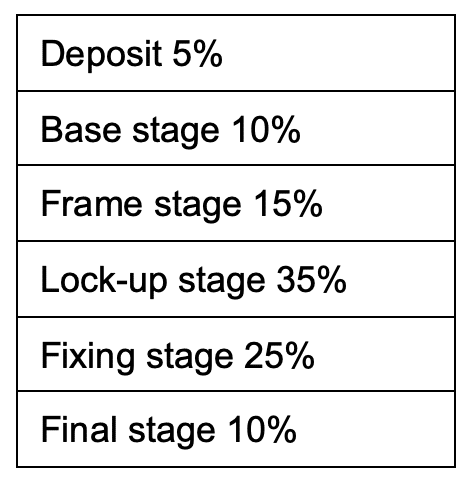
So, you want to build a home? People will call you crazy, but don’t worry, I like you already and we’re going to get along just fine.
Hi, I’m Narelle Glynn, a property buyer’s agent in Melbourne. I also happen to have completed six building projects including a full home build.
I spend a lot of time with my clients evaluating homes against one another. The truth is no two established homes are the same and there will be things you like and things you don’t.
When you build (or renovate) a home, you get to decide how it comes out.
A building project isn’t for the faint-hearted. If the very idea of making dozens of decisions and navigating costs, contractors and construction curveballs gives you sweats, then I don’t recommend rushing into one.
We’ve found our projects extremely rewarding and learnt a bucketload along the way. Read on to understand what to expect from a build and how to avoid some common pitfalls.
(Please note the below does not relate to using a volume builder).

Yet to get your foot on the property ladder? See: How a single parent can buy a home.
DEFINE YOUR PROJECT
Spend time documenting what you want in a brief.
Not just Pinterest boards, friends, this is the actual detail room by room. This brief will be what you give to your architect or draftsperson.
You want to build once and get as much right the first time. Updates down the track are possible of course but spending the time upfront on the floorplan and basic amenities will pay dividends later.
So, for example in the kitchen:
- How big should it be?
- How much storage and bench space do you want?
- What appliances will you install?
And in the bathroom:
- Do you want a shower and a bath, double vanities and separate toilet?
- Will the bedrooms have built-in-robes?
Prioritise items into must-haves and nice-to-haves in case you need to trim items out to fit your budget.
RUN THE NUMBERS
Most of us will borrow funds from a lender to finance a building project, so speak to your bank or a mortgage broker to find out how much you can borrow. Mortgage brokers can help you find the best deal available for your circumstances.
When it’s time to lodge your loan application, your lender will ask for detailed project plans and specifications to value the project. Once your loan is approved, the bank will drawdown funds to pay your builder at the construction stages.
For more support with your mortgage see: 5 Things banks will look for before approving your home loan.
GATHER YOUR TEAM
This is a big project and you can’t do this alone. You’ll need a team of professionals to play a role in each part of the process.
DESIGN
Architects typically charge 15% of the building contract cost and their services include concepts, detailed design and construction drawings. They also administer and project manage the build so that all the required approvals are obtained and the end product reflects what was designed.
Architect-designs result in well-resolved dwellings that meet the detailed brief of the client and respond to the site and surrounds. If you place a high value on aesthetics, usage of space, energy efficiency, shadowing, and showcasing a unique or artistic look then you will want to use an architect.
If, however, your project is straightforward or you want to closely replicate something you’ve seen, drafting services are an affordable alternative to architect designs.
BUILDER
Careful selection of your builder couldn’t be more paramount.
Your architect or draftsperson may provide good contacts, but always make sure you’re comfortable and make your own enquiries. Ask to see a builder’s work and talk to their clients about what it’s like to work with them and how happy they are with the finished product.
The two biggest risks in a build are the costs and timeframe.
Your builder will price up the components of the build to arrive at the Contract Price.
Costs will be driven by labour and materials which will vary based on the quantity and quality of:
- Specifications (i.e. the finishes you select such as laminate vs. stone vs. marble benchtops)
- Construction style (i.e. straightforward or architectural); and
- Site complexity (i.e. soil type, sloping block, site access)
A good rule of thumb we work on is to budget an extra 10% on top of the Contract Price to cover variances.
Your builder should use the standard domestic building contract and quote a fixed price.
Expect to pay for the build along the following schedule:

PLANNING APPROVAL
Each state in Australia has its own planning rules and guidelines.
If you need planning approval for your build then prepare for anywhere between a 3 month to a 12 month wait as the planning team review your application, advertise it to impacted neighbours and make their decision.
If your neighbours object to your plans that will delay things further. Worst case scenario you could up fighting objections in an administrative tribunal. If you can keep your build within the guidelines, you’ll save time, stress and money fighting the council and neighbours.
Planning permits have an expiry date (usually 2 years) within which you have to start your project and often a time within which you must finish the build (this is obviously so we don’t have half-finished construction sites in our streets).
MONITOR PROGRESS
You’ve broken ground and that’s a very significant milestone. You’ve done a lot to get here!
The building contract will include a timeframe for the building works with an allowance for reasonable delays (such as weather) and there are penalties payable when the build isn’t completed on time.
I recommend asking your builder to put dates to each of the contract stages. That way you know when to expect to reach each stage and can detect slippage from the timeline earlier rather than later.
A full house build can take anywhere from 6 months to 2 years. On average it will be 12 months.
My experience is that the stages to lockup happen very quickly and then the remaining stages seem to drag on forever. That’s because after lockup is when many of the other trades such as electricians, plasterers, joiners and painters come in, many of whom want clear access to the site without tripping over the other trades.
Chat with your builder about what you should expect during that period to manage your excitement and frustration!
INDEPENDENT INSPECTOR
Your builder will arrange a licensed building surveyor to sign off at certain stages of the build to ensure the construction matches the approved building permit drawings and meets the building code.
If you don’t have an architect to project manage the build, and don’t know what you’re looking for, for peace of mind I recommend engaging an independent licensed builder to inspect progress at the various stages, or any time you are not comfortable with construction.
DEFECTS
It will vary by state, but in Victoria you’ve got three calendar months after the date of final payment to identify defects. You must issue your builder a notice of these defects within 10 business days of the defect period end.
The builder must rectify defects within 20 days of the notice. Domestic Building Insurance provides an indemnity for non-structural defects for 2 years and structural for 6 years if your builder dies, disappears or becomes insolvent.
NEIGHBOURS
There’s no denying a build next door or in the street can be a pain in the behind. At a minimum there’s tradie trucks taking up parking and at worse there’s noise, dust, heavy machinery, road closures and temp fencing for months.
We all know that neighbour who carried out their own project without so much as a courtesy visit who then goes on to complain all the way through someone else’s.
Don’t be that person.
For your immediate neighbours, arrange a time to stop in and share your plans. Encourage them to share any concerns (on the spot or after they’ve thought about it) and make sure they have your contact details. This way when they get the notice of the planning application from your council they’ll have heard it from you first.
For other neighbours in the street, sending a courtesy note telling them what’s planned, how excited you are and what the timeline is goes a long way.
LANDSCAPING
Don’t let landscaping be an afterthought on your project.
Good landscaping frames the house, integrates its interiors with the exterior and means you can get the most amenity from the expensive land you bought. When build is finished the site will end up looking like a barren wasteland of compacted earth.
Unless you plan and budget for landscaping works your beautiful home will stand on a piece of dirt. What a shame that would be!
WHITEGOODS
Your architect and builder will need to know the specifications of your selected appliances.
Choose your appliances, but do not purchase and take delivery until just before you need them, otherwise your warranty is ticking away for nothing.
SAMPLES
Samples from suppliers are awesome to take home and mull over. It’s so handy to have those itty-bitty stone and carpet samples but a word of warning: As much as you can, look at full size samples and installations so you can see the finish in its final state. A subtle and repeating pattern might not be on the sample piece of carpet you were given, or the vein through the stone sample might not be as consistent on a full slab.
Always bear in mind that the sample is just that and the supplied product may vary slightly.
Further reading: Your guide to building a long-distance home.

So, there you have it: My summary of what to expect when building and tips on where to focus.
Happy building!














